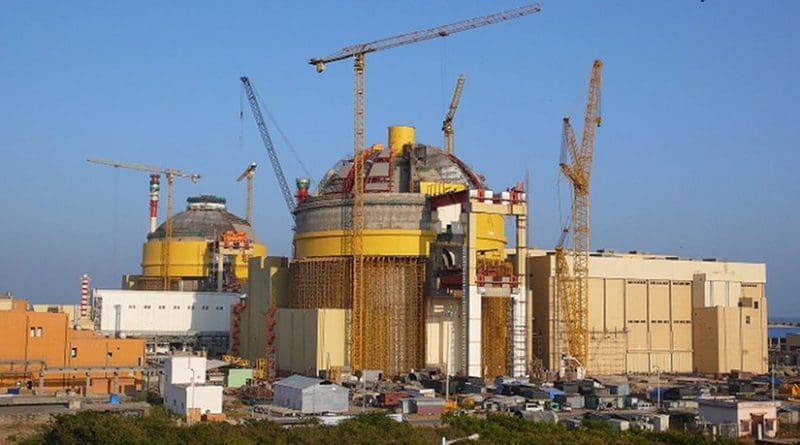Kudankulam: Nuclear Energy And Protest Movements – Analysis
By IPCS
By Shubhra Chaturvedi
The Kudankulam Nuclear Power Project (KKNPP) in India has brought to light the debate between the preeminence of national identity and the notions of human security. Do the civil society movements have any relevance in strategic decisions related to nuclear issues?
The KKNPP is ready to go critical in a few days. The 1000 MW atomic power plant, which is the first of its kind for India has finished the phase of fuel loading. The Economic Times reported that the process of loading 163 bundles of enriched uranium began on 19 September 2012 and it was finished by 2 October 2012. Shiv Abhilash Bharadwaj, Director (Technical), Nuclear Power Corporation of India Limited was quoted saying, “We have two more steps to attain first criticality. First the reactor will be closed after clearance from the AERB which will be followed by pressure tests.” The technical process for the reactor to go critical moves on consistently and in the background the Indian civil society continues its struggle against the nuclear power plant and attempts to stop it.
The reactions from the Sri Lankan media to the Kudankulam nuclear power plant about environmental negligence highlighting the ignorance shown by the Indian state towards basic survivability concerns of the common people were seen as attempts to paint India as an irresponsible power. However, the massive domestic reactions against the KKNPP within India have also been consistent since the very emergence of the idea of the Kudankulam nuclear power plant itself. Protests against the power plant have ranged from ostensibly peaceful ones (supposedly following the Gandhian philosophy of Satyagraha) to the violent ones. The Peoples Movement Against Nuclear Energy, a movement started in 2003 with the sole intention of shutting down the KKNPP, is still trying to make the voices perceptible.
The coordinator of the Peoples Movement Against Nuclear Energy, S P Udaykumar called for an agitation at sea in early October 2012 which garnered substantial response in the Kanyakumari district. Protesters, including a few women, were at the wheelhouse of mechanised boats raising slogans against the KKNPP through the public address system even as the security personnel kept a watch. There have been violent outbursts too, that have led to open fire by the police and even the death of one protestor at Idinthakarai, however, this has not stopped the people from going ahead with their efforts. The idea behind these protests is to make the government and the people aware of problems faced by the residents of the nearby regions due to displacement as well as due to the security concerns.
The state has not overtly claimed indifference towards the movements and yet some like the Chief Minister of Tamil Nadu requested the public to stay away from the ‘false campaign’ since the KKNPP was not considered life-threatening. Meanwhile, Jayalalitha defended the violent police action that lead to the death of one protestor in the name of the common good.
In defense of the state, Jayalalitha earlier had claimed that an amount of Rs 500 crore had been allocated for the rehabilitation and for the development of the local people. Yet, these issues have not been addressed properly. The protests that mostly speak about the plant’s threat to livelihood prove two things – the huge gap between promises and their execution in India and the lack of awareness amongst people on such plans.
A fuctional Kudankulam nuclear plant will ensure that Indian ambitions of producing 63,000 megawatts of nuclear power by 2032 (a 14-fold increase from current levels) is achieved. But is that enough reason to overlook these movements that highlight issues of human security? While the activists, who are a well crafted combination of the intellectuals (with the likes of poet Sugantha Kumari, writer Sarah Joseph, Gandhian P Gopinath ) as well as the local people are trying to make a point, the state is busy planning the course of action towards a brighter and bolder nuclear India. The inference that can be drawn from this is quite clear, that the nuclear ambitions of India are way above petty issues like domestic upheaval and activism.
The government attitude remains nonchalant to these movements and it is hardly disturbed by the reactions from the various sections of society. Unfortunately, nuclear decisions fall under the domain of high politics and since this is a question of national identity and national ambitions, so these civil society movements stand irrelevant. However, the democratic spirit of India in this aspect is definitely questionable.
Shubhra Chaturvedi
Research Officer, NSP, IPCS
email: [email protected]

